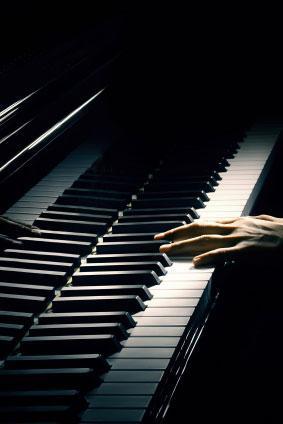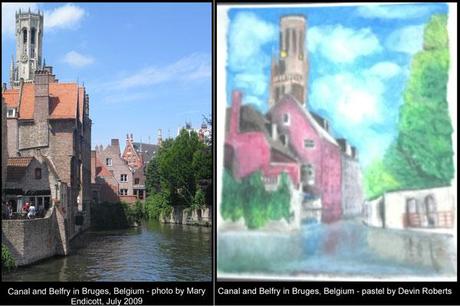
Photo courtesy of iStockphoto.
The music of Steven Vrancken is soft, subtle, relaxing, and reminiscent of a peaceful daydream on an unpopulated, cool, and calm beach. This synthesis of nature aesthetic is filled with ambient energy that slides behind the activity of your thoughts, becoming a deep layer in the tapestry of temporal experience. The quite tumbling of the ocean surf meets the counterpoint of the wind’s wistful and restless syncopation. Slowly cascading melodies that fade into the momentary rests of reverberant stillness. Listening to Steven Vrancken’s piano performances on his album Into Resonance casts one into a reverie of the auditory imagination.
Vrancken creates a musical texture that is a meandering and curious tranquility. A hint at a motif from time to time, but form, structure, and cadence are as fleeting as a butterfly that touches upon your palm for a brief inquisitive interlude. Melodic flows, mostly monophonic, get occasional accompaniment by chorded combinations and hummed harmonization. The music conjures forth the ambience of a dream, often with an airy quality and always with an unanticipated yet comforting direction. From the haunting opening of “Nature’s Welcome,” to the graceful sentiments of “Embracing Spirit,” and on to a charming finish with “Into Resonance,” Steven Vrancken’s playing carries the consciousness away, a leaf in the breeze.
All of the songs within Into Resonance are improvised instrumental pieces, with a solo piano dominating throughout, sometimes accompanied by Steven’s vocalizations. There is no lyric, with the vocalizations reminiscent of Native American singing or perhaps the droning of an Aborigines’ didgeridoo. The improvisational work is impressive, especially since Vrancken is self taught and does not work from sheet music. When I asked Steven why he decided to create a CD of pure improvisation he told me, “Well, because, until now, my main inspiration is nature… the flowing of water in a small creek in a wood: it`s like a stream of consciousness, never the same, always changing, and giving peace of mind.”
It is thought that improvisation is the highest form of free expression in music. Artur Jaschke analyzes this common belief in his dissertation, Controlled Freedom: Cognitive Economy vs. Hierarchical Organization in Jazz Improvisation, and he makes the case that it is not free will that characterizes improvised jazz performances. Rather they are based on pre-learned parameters and boundaries to around ad-hoc expression. Jazz improvisation happens within a musical framework that allows for loose application within ruled based patterns, and so is not properly a pure form of freedom. Jaschke considers improvisation to be a type of controlled freedom. This makes sense to me. I know the minor key of A really well on my guitar and I can improvise within this key forever, but this free expression does end up sounding a lot like the sorts of patterns I often play, and of course I don’t know how to improvise in any other keys. Controlled freedom reminds me of something an old music theory teacher used to say “you must learn the rules first, before you can break them.” The conventions of music control the freedom in performances.
In the case of Steven’s music, I am not sure controlled freedom suitably explains what is taking place, and in fact what Vrancken does may be more liberating for him than it is for jazz players. There are controls on Steven’s music, he is constrained by the tones of piano and voice, but less so than jazz musicians who have been taught the rules and tricks, and who must respond to other players and instruments. Steven’s performance could be better described as natural freedom, the liberty of playing music with no parameters except the instruments, and of course, resonance.
Into Resonance is an especially relaxing CD. So relaxing in fact, that my wife heard me listening and commented that the music would be a great thing to play for young children when they are going down for a nap. At first I thought that this would not be a complement to Steven, but having since watched YouTube coverage of his Dreamtime Concerts I think he would be pleased with the idea of children getting their naptime to his CD. At the Dreamtime Concerts, Steven spontaneously conducts his improvised musical performance in a hall where the audience is lying down on mattresses and appreciating the tonal atmosphere poetically prone. I have never seen anything quite like it.
To realize a personal resonance to a thing is to connect with it in some way that causes you to return to it as a matter of personal desire. It is easy to think about personal resonances in terms of a piece of music that catches your ear and ignites a longing to hear it again and again. Another way in which I feel personal resonances is by encountering meaningful coincidences, and especially a web of coincidences. I encountered a mesh of meaningful connections I had to Steven, things extrinsic to his music but which drew me to it and led me to want to write about this article.
Steven contacted me after he stumbled upon my blog, and asked if I would be interested in listening to his music. No doubt the dominant factor in his stumbling across me is that my blog is called Realizing Resonance and his piano CD is titled Into Resonance, and there is something incredibly poetic about the idea that the first vibration in a set of resonant coincidences was an attraction based on the use of the word “resonance.” It is certainly the reason why I responded with intrigue and agreed to listen. Many coincidences followed from there, my brother Devin is a professional piano player and this peaked my interest in Steven’s work, plus my brother Devin is a painter who mostly depicts beautiful landscapes. Landscape paintings capture the natural aesthetic in a visually splendid snapshot in time, musical composition is temporal and can capture the continuous flux of nature, as Steven’s songs do. I wrote about Devin’s art last year in the article, The Art of Devin Roberts and Natural Aesthetics, and one more coincidence that I can’t help mentioning is that Steven is from Belgium and his parents were married in Bruges, which is a connection for me because I have hanging a marvelous pastel depiction of the Belfry in Bruges, Belgium that my brother painted from a photo that our mother had taken, and which is strikingly similar to a photo that my wife Mary took when we were in Belgium. Coincidentally I have also written about my time in Belgium in the article, Wine in Bordeaux, Beer in Bruges, and Contextual Temperance. These are meaningful coincidences which give me a sense of stronger purpose.

I recommend listening to Steven Vrancken if you want to relax with thoughts of nature streaming through your mind. Music is a very profound and deeply emotional experience, and sometime it takes listening to pure musical expression as it unfolds over time to truly appreciate this about music in a way to you don’t get from listening to the latest pop song. Check out this short YouTube documentary, About the Piano Music from Steven Vrancken, and another really intriguing TV spot from 2008 about his unique Dreamtime Concerts, Piano Concerts & Music by Steven Vrancken. Finally, download Into Resonance and drift away on a cloud.
Steven has suggested a nice holiday bonus for my readers. The first three readers to share this article on their favorite social network, leave a comment on the Paperblog edition of this article (here is the link if you are not reading this on Paperblog now), and email me at [email protected], will get a free digital copy of Into Resonance by Steven Vrancken.
Jared Roy Endicott

Works Cited
Jaschke, Artur C.. ”Controlled Freedom: Cognitive Economy versus Hierarchical Organization in Jazz Improvisation”. Academia.edu. Amsterdam: University of Amsterdam, 2011. Web. 9 Dec. 2012.



COMMENTS ( 1 )
posted on 17 December at 01:22
CORRECTION: Steven's parents were not married in Bruges, but began the first night of their honeymoon there.